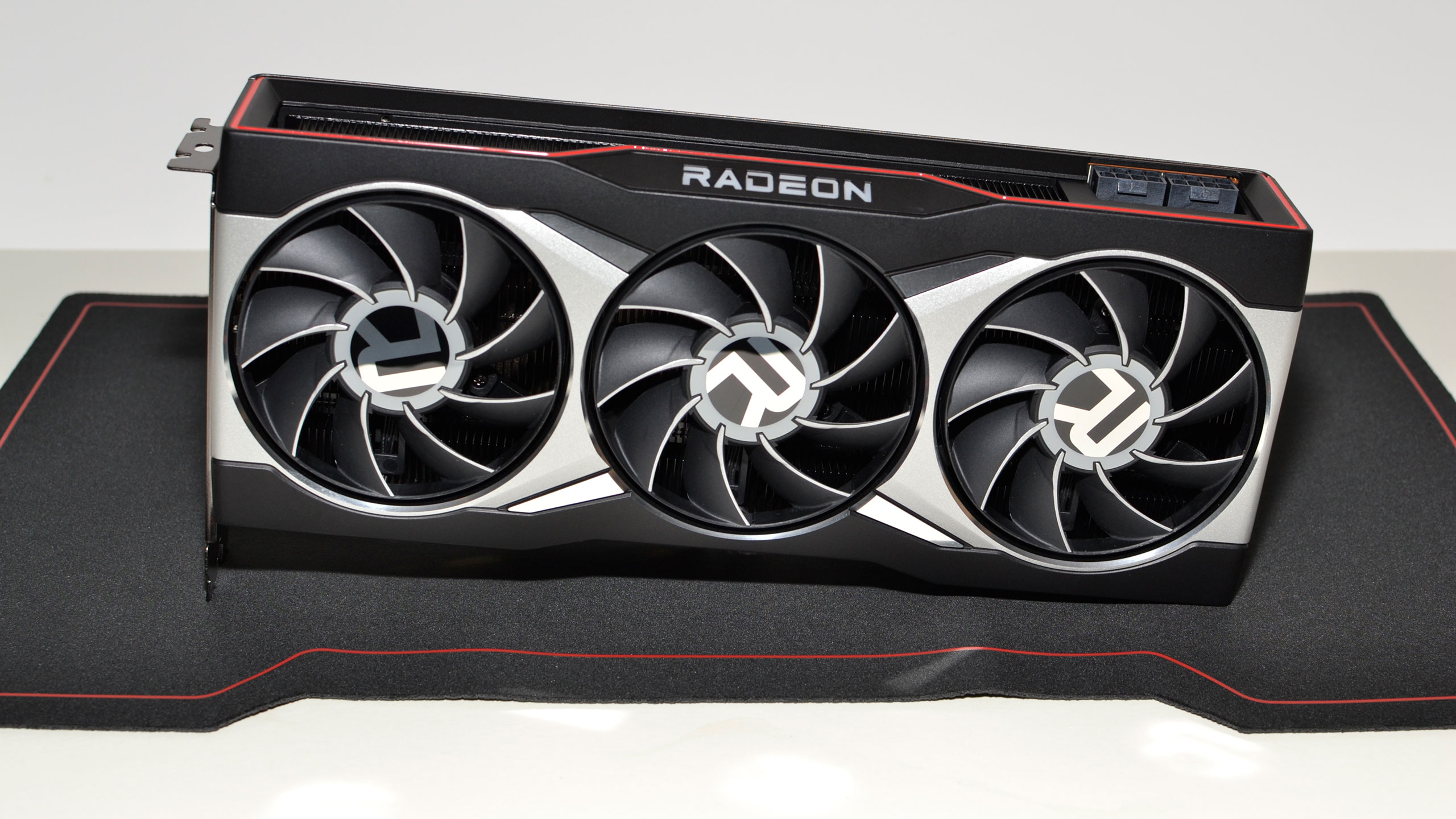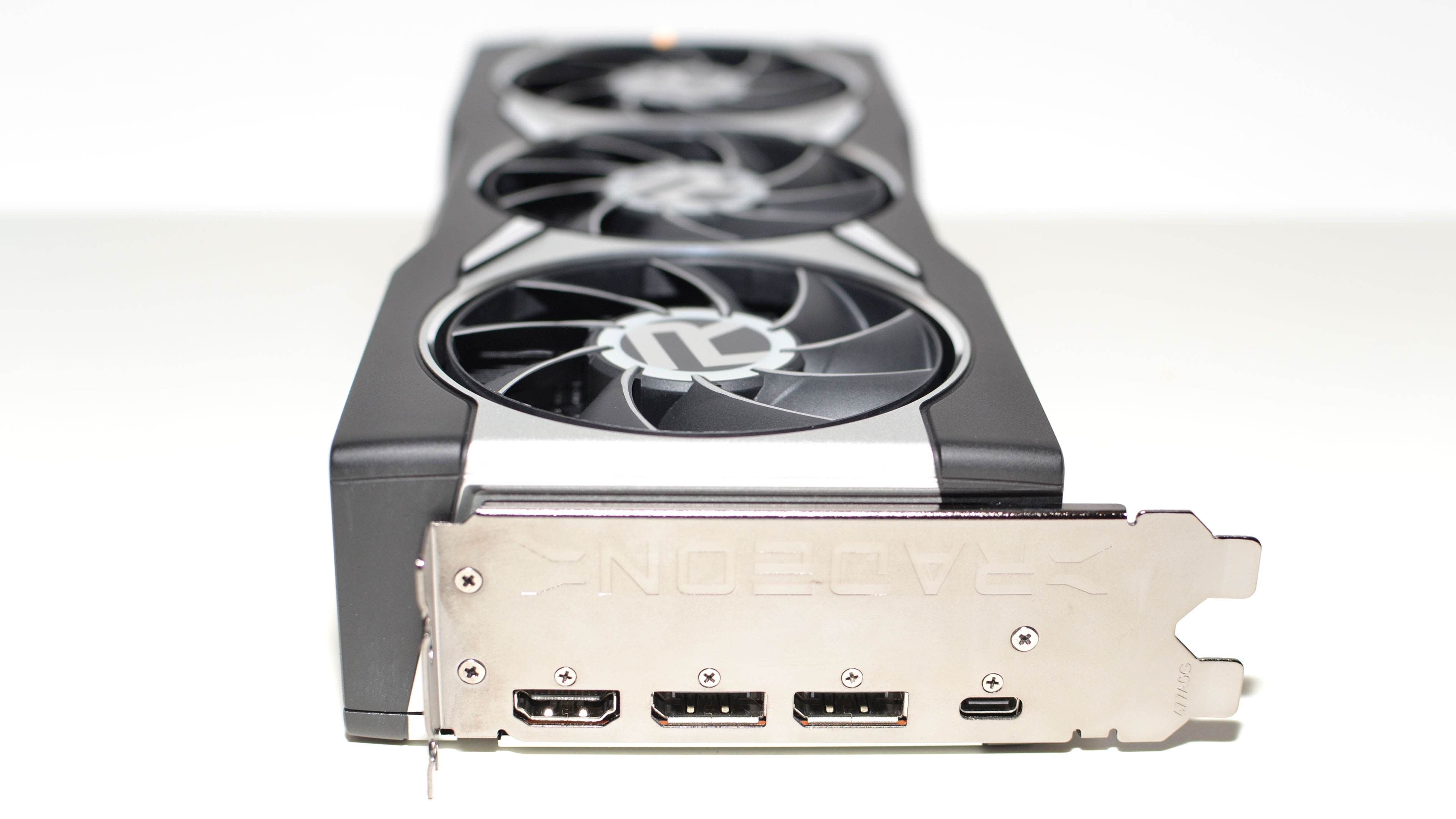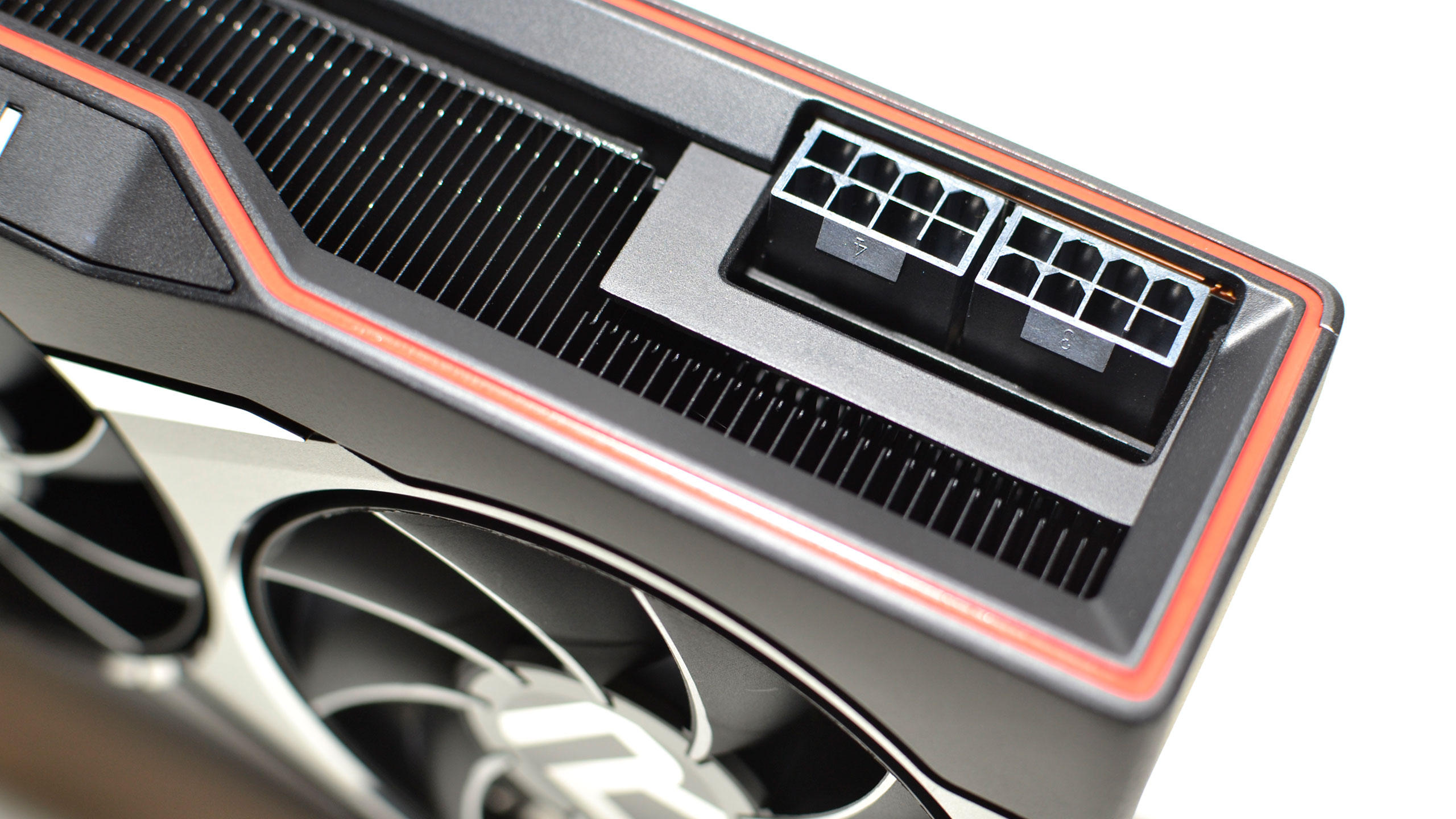Tom's Hardware Verdict
The Radeon RX 6900 XT is now AMD's fastest GPU. However, it's only incrementally faster than the RX 6800 XT, making the $1,000 asking price a tough sell.
Pros
- +
Biggest Navi
- +
Decent overclocking
- +
Does well in certain Proviz workloads
Cons
- -
Not that different from 6800 XT
- -
Extreme pricing
- -
Expect very limited quantities
Why you can trust Tom's Hardware
The AMD Radeon RX 6900 XT is officially AMD's new halo product, surpassing the Radeon RX 6800 XT and RX 6800 by offering the fully-enabled Navi 21 GPU with 80 Compute Units. The latest generation GPUs sit atop our GPU Benchmarks hierarchy and rate as some of the best graphics cards currently available (if we use the term "available" loosely). The 6900 XT is also the most expensive AMD graphics card we've seen in quite some time — the last time AMD sold a GPU priced at $1,000 or more was the Radeon Pro Duo (2016), a very limited quantity dual-GPU card. With RX 6800 XT taking on RTX 3080, the goal is clear: AMD wants to offer competitive performance to the GeForce RTX 3090 while undercutting Nvidia's price by $500.
All of that is sort of a moot point, of course. Even eight months after the official launch, the RX 6900 XT remains virtually impossible to find in stock, just like all of the other RX 6000 and RTX 30 series graphics cards. Our GPU pricing index looks at eBay prices for the various cards, and while the RX 6900 XT technically only costs 55% more than the MSRP, it's still a lot more than we'd recommend paying. We're refreshing this review with the latest details but keeping the original performance results. You can see the full view of how performance stacks up in more recent reviews like the RTX 3080 Ti, but until prices reach something approaching normalcy, buying a latest generation graphics card remains a serious pain in the nether regions.
Undercutting the 3090 price is all well and good, but there are a couple of problems when comparing the GeForce RTX 3080 and 3090 to the Radeon RX 6800 XT and 6900 XT. First, RTX 3090 more than doubled the VRAM of the 3080. It also has a wider memory bus and 20 percent more shader cores. Finally, it increased the power target by 10 percent and often delivered superior performance in professional workloads. In contrast, the RX 6900 XT has 10 percent more shader cores than the 6800 XT. And that's it.
Let's get straight to the point. On paper, the RX 6900 XT doesn't look like a good deal. We're not saying the RTX 3090 is a better deal for gaming purposes, but at least it offers some tangible benefits over the RTX 3080. Again, all of this is somewhat academic right now, as supplies of the latest generation graphics cards have proven woefully inadequate. If you can find an RX 6900 XT in stock for $999, have at it! But it continues to sell out just as quickly as its lesser siblings — faster, in fact, since supplies of the RX 6900 XT tend to be even more limited considering it requires a fully-enabled Navi 21 chip. Yields of that quality of chip won't be higher than the partially disabled chips in the 6800 XT, which are still nowhere near sufficient to meet demand.
| Graphics Card | RX 6900 XT | RX 6800 XT | RX 6800 |
|---|---|---|---|
| Architecture | Navi 21 XTX | Navi 21 XT | Navi 21 XL |
| Process Technology | TSMC N7 | TSMC N7 | TSMC N7 |
| Transistors (Billion) | 26.8 | 26.8 | 26.8 |
| Die size (mm^2) | 519.8 | 519.8 | 519.8 |
| CUs | 80 | 72 | 60 |
| GPU Cores | 5120 | 4608 | 3840 |
| Infinity Cache (MB) | 128 | 128 | 128 |
| Ray Accelerators | 80 | 72 | 60 |
| Base Clock (MHz) | 1825 | 1825 | 1700 |
| Boost Clock (MHz) | 2250 | 2250 | 2105 |
| VRAM Speed (Gbps) | 16 | 16 | 16 |
| VRAM (GB) | 16 | 16 | 16 |
| VRAM Bus Width | 256 | 256 | 256 |
| ROPs | 128 | 128 | 96 |
| TMUs | 320 | 288 | 240 |
| TFLOPS FP32 (Boost) | 23 | 20.7 | 16.2 |
| Bandwidth (GBps) | 512 | 512 | 512 |
| TDP (watts) | 300 | 300 | 250 |
| Dimensions (mm) | 278x107x50 | 278x107x50 | 278x107x39 |
| Weight (g) | 1505 | 1504 | 1389 |
| Launch Date | Dec-20 | Nov-20 | Nov-20 |
| Launch Price | $999 | $649 | $579 |
There's really not much to say about the specs that we haven't already covered. The RX 6900 XT has the full 80 CUs and 5120 shader cores that the Navi 21 GPU offers, and the remaining specs, including memory speed and TDP, are the same as the RX 6800 XT. Which isn't to say that there aren't differences in the silicon.
Binning and sorting chips from silicon wafers is nothing new, but the best chips often come from closer to the center of the wafer, where there are fewer defects. Since the 6900 XT requires a fully functioning Navi 21 chip, it almost guarantees other characteristics like power and voltage requirements will be better as well. How much does that matter in practice? If you're hoping to overclock and reach maximum performance, the silicon lottery can get you an extra few percent. Considering the 6900 XT already costs 50 percent more than the 6800 XT, however, that's a big jump in price for a likely minor improvement in overall performance.
AMD Radeon RX 6900 XT: Unboxed and Unwrapped












The Radeon RX 6900 XT looks identical to the RX 6800 XT, except for the product label. The packaging isn't quite the same, however. Inside the main box, the RX 6900 XT comes wrapped in a mouse pad. It's a nice little extra if you need a mouse pad or AMD swag. It's a relatively large pad as well — not big enough to cover your entire desk, but much larger than a basic pad.
Get Tom's Hardware's best news and in-depth reviews, straight to your inbox.
The RX 6900 XT is a dense graphics card, weighing slightly more than the RTX 3080 while sporting similar dimensions. It's a bit thicker, occupying 2.7 slots, but it's also about 2cm shorter. You could potentially fit it into a smaller build, but we recommend exercising some caution as ejecting 300W (or more) or heat into a small case will hurt performance. Actually, if you're doing a smaller case, just save yourself some money and buy the 6800 XT — we'd bet once thermals level out, the two cards will perform nearly the same.
Like the RX 6800 cards, the 6900 XT includes a single HDMI 2.1, two DisplayPort 1.4, and one USB-C video output. If that doesn't meet your needs, keep an eye out for third party cards. We've heard there will be RX 6900 XT cards from AMD's AIB partners (contrary to some earlier rumors), which makes sense as anyone making an RX 6800 XT could use the same design for RX 6900 XT. We're not sure when those cards will be available for purchase, however.
There are two 8-pin PEG connectors for power, rated for 150W each. Combined with the 75W from the PCIe slot, power should be more than sufficient for normal operation. We did see slight power spikes when starting up certain workloads (FurMark, specifically), but these shouldn't pose a serious problem to any quality power supply that can deliver 850W. We do recommend using a single rail PSU if possible.
Radeon RX 6900 XT Overclocking
MSI Afterburner still doesn't support RX 6000 series GPUs at present, leaving us with AMD's built-in overclocking tools. We could just use Rage Mode, but all that seems to do is raise the power limit, so we set about doing some manual tuning.
Memory seemed easy enough to max out, and cranking the power slider to maximum as well doesn't generally pose any problems. That leaves the GPU clock, voltage, and fan speeds, the latter of which we tuned to favor cooler temperatures over quieter operation. We set the RAM to 2150 MHz, dropped the GPU voltage to 1125 mV (down from 1175 mV), and set about testing.
We started by looping the Unigine Heaven 4.0 benchmark in a window at 1440p extreme, then bumped up the GPU clock to 2600 MHz to check for stability. We found that the power limit becomes a factor long before the maximum boost clock comes into play. With a 115 percent power limit in place, that gives the GPU up to 345W of power, and that's pretty close to where it landed. Clock speeds then fluctuate according to the demands of whatever game or workload is running, with average clocks in the 2400-2550 MHz range.
While Heaven proved stable in our initial tests, we did encounter some issues in a few other games, which eventually led to the slightly revised overclocks you can see above. We dropped the RAM 10 MHz to 2140, bumped the voltage back to 1150 mV, and that seemed to fix the problems. Additional time spent tuning might eke out a few more MHz, but for most users, simply enabling Rage Mode would do most of the dirty work — or set the RAM speed to 2100 and max out the power slider for a slightly higher result.
It's worth noting that while AMD lists the official boost clock of the RX 6900 XT as 2250 MHz, in AMD's own drivers, the boost clock shows up as 2519 MHz. You won't normally see clocks quite that high, but you could with Rage Mode. In that sense, AMD has taken a page out of Nvidia's book by advertising a lower boost clock than what you'll get in many games. We appreciate this, and the combination of increased power limits and a minor bump to the maximum boost clock gave us a decent result.
Overclocked results are present in our benchmark charts, but not in the DirectX Raytracing (DXR) suite. The net improvement was around 5 percent, and 7 percent at 4K, which isn't that much of a boost to performance. There's a decent chance third party cards may come with better factory overclocks than what we achieved.
MORE: Best Graphics Cards
MORE: GPU Benchmarks
MORE: All Graphics Content

Jarred Walton is a senior editor at Tom's Hardware focusing on everything GPU. He has been working as a tech journalist since 2004, writing for AnandTech, Maximum PC, and PC Gamer. From the first S3 Virge '3D decelerators' to today's GPUs, Jarred keeps up with all the latest graphics trends and is the one to ask about game performance.
-
Makaveli i'm confused is this an old review that was reposted?Reply
It mentions AMD's need a competitor to DLSS like FSR isn't already out, then there is mention of the 3080ti like it hasn't been confirmed yet. -
JarredWaltonGPU Reply
Yeah. For various reasons, our reviews were initially done as a single page in a different template (that doesn't show scores and other minor differences). One of the managing editors at Tom's Hardware is going back through some of my recent graphics card reviews and switching them to the review template. The text and content hasn't been changed, but I guess it posts with the new date.Makaveli said:i'm confused is this an old review that was reposted?
It mentions AMD's need a competitor to DLSS like FSR isn't already out, then there is mention of the 3080ti like it hasn't been confirmed yet. -
dunkyboy Reply
Wow. You are a tech website and you can't work out how to change the date of a post. This really doesn't do good things for your credibility.JarredWaltonGPU said:Yeah. For various reasons, our reviews were initially done as a single page in a different template (that doesn't show scores and other minor differences). One of the managing editors at Tom's Hardware is going back through some of my recent graphics card reviews and switching them to the review template. The text and content hasn't been changed, but I guess it posts with the new date.
You also then end up spamming my news feed with old irrelevant articles. -
NeoMorpheus Thanks for the review.Reply
I honestly wish that sites would stop being scared of nvidia marketing dept and place a disclaimer that all nvidia tech is really a lame way to lock the customer to their hardware, as proven by AMD FXR and the anti-consumer crap called dlss. -
Howardohyea Reply
one thing, coding and hardware isn't the same at all. Secondly, if you don't like their articles then go read another publisher's. Don't complain about it in the comments.dunkyboy said:Wow. You are a tech website and you can't work out how to change the date of a post. This really doesn't do good things for your credibility.
You also then end up spamming my news feed with old irrelevant articles.
Personally I like the formatting where it's divided into different pages, makes finding benchmarks easier.
Now here's my thoughts on the 6900XT: absolute joke, just like the 3080Ti and 3090.
If literally all you care about is gaming the 3080 and 6800XT are excellent cards (at normal pricing), and like the article pointed out, there's literally nothing different between the 6800XT and 6900XT except the cores. Memory and everything else is the same. Might save 50% price for 10% performance.
At least with 3090 you get 24GB of VRAM so content creators will love that. Plus it's faster than the 6900XT so people looking for the "absolute best" will go for the 3090 instead of AMD. -
JarredWaltonGPU Reply
I actually went through and reread the old review, then updated sections that were no longer correct and/or relevant. So, for example, FSR is now out, the RTX 3080 Ti is also here, prices are still fubar. But the review as it stands now should be generally correct in light of the current market situation.JarredWaltonGPU said:Yeah. For various reasons, our reviews were initially done as a single page in a different template (that doesn't show scores and other minor differences). One of the managing editors at Tom's Hardware is going back through some of my recent graphics card reviews and switching them to the review template. The text and content hasn't been changed, but I guess it posts with the new date. -
Kamikazekerr Personally Nividia is hitting it's marks there simple but effective I've had a 3090,80,70oc,3060ti and a 3060 junk and Personally I only play warzone prior to the dlss for cards like the 3070 even on custom cooling it struggled badly even turning it right up.with custom cooling, the 3080 vram took a big hit and aswell my personal favorite 3090 vram gauge looked like you threw 5 bucks in a Lincoln continental. LOL......Fast forward a few months I get an ASUS LC 6900XT it ran fine but warzone cranked up his hard on any card while the 6900 remained cool with all the buttons and dials and lack of software I found the card did not perform to my liking and sold it and jumped back into a rog 3070...but then I go and buy a refence amd 6900xt because of the look and ekwb water block. Getter plugged in and bam 100 degrees at the junction while I wait for my water block I've got 3 arctic fans force feedijg this thing air and still to high 80's and 90s which I do not like not to mention artifacting outta the box using only amd oc settings...so I pull it apart today no thermal anything under backplate..add my own from ekwb....then scrape the pad off the cooler side of the chip then watch the stock thermal pads almost Disintegrate under there own weight... replace them and repaste went fromReply
92 temp and 95 plus junction temp down to 75 to 82 ish temp and still a steady junction temp about 92 when working but still force feeding it air all around disappointment and the artifacting concerns me it's hit or miss now hopefully it comes around with the water. BUT all in all I would not recommend anything amd gpu related at this time...I hope to change that in the future but as of right now I'd take my Rog 3070 onwater over this 6900xt in performance for my needs and user friendly software and settings
